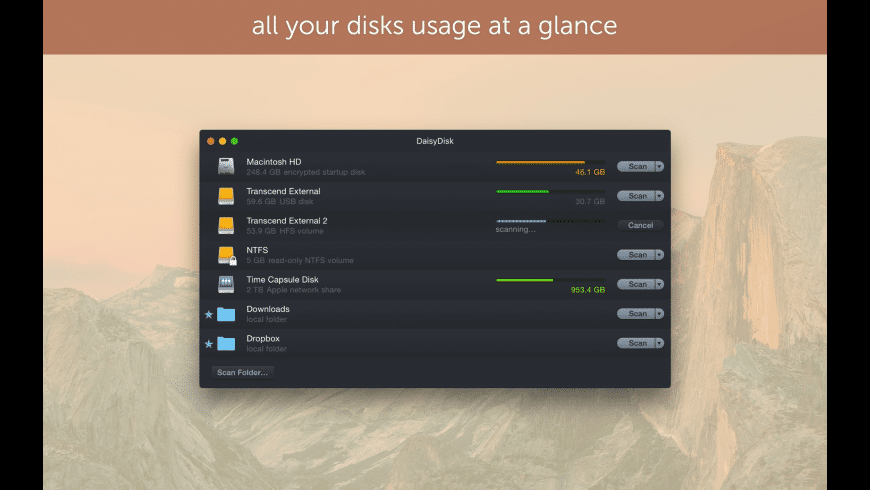Daisydisk Private
Mar 11, 2020
DaisyDisk, chosen by Apple as a Mac App Store ‘essential’, provides a cleaner and more interactive circular interface for visualizing Mac’s hard drive. 9to5mac For only ten bucks, DaisyDisk is a simple, convenient utility for every Mac owner, and it gets the job done well for less technically-inclined users. I am always on the lookout for a new, fun, more efficient utility App for the Mac. Lately, I have been playing around with DaisyDisk that is an App that displays how your hard drive space is being used. This is a very well designed App and it is totally fun to use.
[Important update] DaisyDisk 4.10 adds support of APFS Snapshots
- Jul 22, 2019 DaisyDisk 4.7.2.2 Crack With License Coad Free Download 2019. DaisyDisk Crack allows you to see the use of the disk and the free edition of the disk by quickly identifying and eliminating the large information that is not used.
- DaisyDisk 4.7.2.2 Crack With Serial Key Free Download 2019. DaisyDisk four Serial Key For Mac scans the Mac and then provides an inventory of the places that can be examined. It allows you to send explicit gadgets to the “Compiler” panel and then delete the information from the application, with a.
Ever since macOS Catalina was introduced, many Mac users noticed that their disks eventually get full without obvious reason. A quick scan in DaisyDisk typically reveals a big chunk of “hidden space“, which means the system is using more disk space than it’s possible to reveal by scanning, even with elevated permissions (scanning “as Administrator”).
The reason for this problem is that macOS is making temporary backups of the system, so called local snapshots, temporarily locking big amounts of disk space in an area of the disk that is fully opaque to the users. Eventually when the snapshots get transferred to the permanent storage, such as the Time Capsule, or as the snapshots become too old and get replaced by newer ones, macOS releases the disk space. However, the backup process is continuous and therefore there is always a certain amount of disk space that is locked by macOS for the snapshots.
This is how macOS Catalina works and it’s not supposed to even be a problem or require any maintenance from the user. However, in certain cases, you just need to free up the space urgently, and it’s quite confusing that you don’t have control over a big chunk of your disk.
Thankfully, the new version of DaisyDisk (4.10) is making it much easier to reveal the macOS’ hidden space, and for the part that cannot be revealed – understand its internal structure and even provide tools to reclaim it by demand.
In particular, the new DaisyDisk cuts down the amount of hidden space by revealing some obscure system items such as non-linked content of the “firmlinked” Data volume (under /System/Volumes/Data), the virtual memory volume (under /private/var/VM) and some other.
Daisydisk Private School
Besides, DaisyDisk now shows a breakdown of the hidden space that includes the following items:
- Purgeable space. (You can also see it in Finder and Disk Utility when you inquire info for a disk). This is an amount of disk space, as calculated by macOS itself, which includes the snapshots too. You can forcedly purge this space by deleting it in DaisyDisk.
- [NEW] Snapshots. This is a list of the temporary snapshots, with their estimated sizes. You can forcedly delete any or all of them in DaisyDisk, with a simple drag-and-drop, as you’d do with regular files.
- Other volumes. This is the remainder of the system volumes that are used internally by macOS.
All in all, the new DaisyDisk is making a huge step to return you understanding and control of your disk on macOS Catalina, and probably provides the most exhaustive and informative view of your disk compared to any other disk utility.
The update is free of charge of the existing users. You can download it here. The full change log is here.
Large amounts of hidden disk space may also indicate errors in the file system. You can use the Disk Utility to verify and repair your disk’s integrity. In some cases, you may need to boot your Mac in Recovery mode and run the Disk Utility from there.In the most obstinate cases with APFS disks, you may need to use the lower-level fsck_apfs command-line utility to verify and repair the APFS volume from the Recovery mode.

Daisydisk Private Parts
Similarly, for HFS+ disks, you may need to use fsck_hfs. Beside verifying, you can use it to repair the HFS+ catalog file. WARNING: this operation may not be safe for your data! You should make a full backup of your disk before trying. Please seek professional help on the matter. Sheek louch da cook up mp3 download.